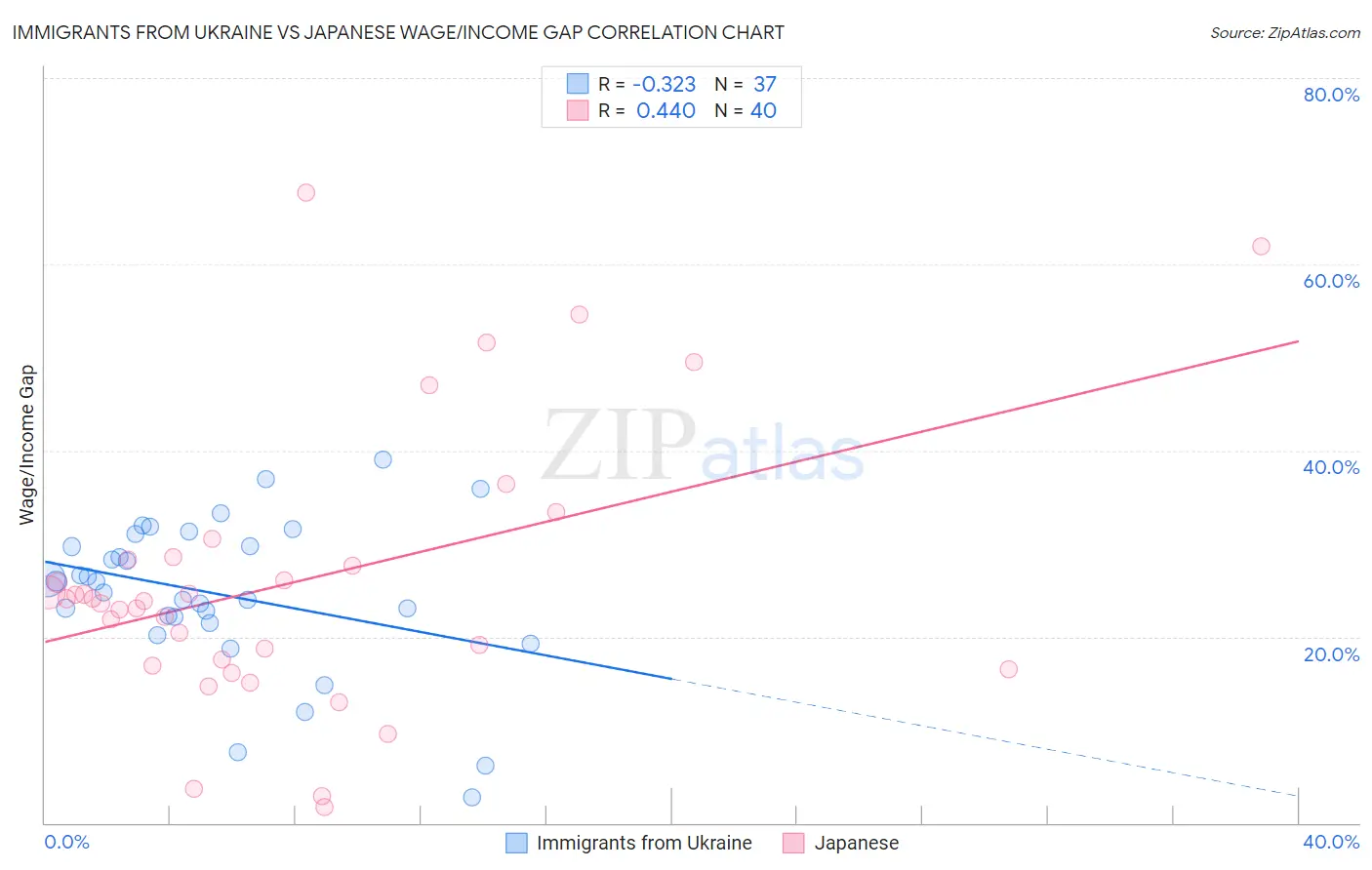Immigrants from Ukraine vs Japanese Wage/Income Gap
COMPARE
Immigrants from Ukraine
Japanese
Wage/Income Gap
Wage/Income Gap Comparison
Immigrants from Ukraine
Japanese
25.5%
WAGE/INCOME GAP
63.8/ 100
METRIC RATING
166th/ 347
METRIC RANK
23.8%
WAGE/INCOME GAP
99.1/ 100
METRIC RATING
101st/ 347
METRIC RANK
Immigrants from Ukraine vs Japanese Wage/Income Gap Correlation Chart
The statistical analysis conducted on geographies consisting of 289,568,179 people shows a mild negative correlation between the proportion of Immigrants from Ukraine and wage/income gap percentage in the United States with a correlation coefficient (R) of -0.323 and weighted average of 25.5%. Similarly, the statistical analysis conducted on geographies consisting of 249,130,971 people shows a moderate positive correlation between the proportion of Japanese and wage/income gap percentage in the United States with a correlation coefficient (R) of 0.440 and weighted average of 23.8%, a difference of 7.3%.

Wage/Income Gap Correlation Summary
| Measurement | Immigrants from Ukraine | Japanese |
| Minimum | 2.8% | 1.7% |
| Maximum | 39.0% | 67.8% |
| Range | 36.2% | 66.0% |
| Mean | 24.6% | 26.0% |
| Median | 25.9% | 23.9% |
| Interquartile 25% (IQ1) | 21.8% | 17.2% |
| Interquartile 75% (IQ3) | 30.3% | 28.4% |
| Interquartile Range (IQR) | 8.5% | 11.2% |
| Standard Deviation (Sample) | 8.1% | 14.8% |
| Standard Deviation (Population) | 8.0% | 14.6% |
Similar Demographics by Wage/Income Gap
Demographics Similar to Immigrants from Ukraine by Wage/Income Gap
In terms of wage/income gap, the demographic groups most similar to Immigrants from Ukraine are Immigrants from Hong Kong (25.5%, a difference of 0.010%), Paiute (25.5%, a difference of 0.060%), Seminole (25.6%, a difference of 0.080%), Peruvian (25.6%, a difference of 0.26%), and Korean (25.4%, a difference of 0.35%).
| Demographics | Rating | Rank | Wage/Income Gap |
| Puget Sound Salish | 73.0 /100 | #159 | Good 25.3% |
| French American Indians | 72.5 /100 | #160 | Good 25.4% |
| Albanians | 69.4 /100 | #161 | Good 25.4% |
| Shoshone | 69.0 /100 | #162 | Good 25.4% |
| Native Hawaiians | 69.0 /100 | #163 | Good 25.4% |
| Koreans | 68.6 /100 | #164 | Good 25.4% |
| Immigrants | Hong Kong | 64.0 /100 | #165 | Good 25.5% |
| Immigrants | Ukraine | 63.8 /100 | #166 | Good 25.5% |
| Paiute | 62.9 /100 | #167 | Good 25.5% |
| Seminole | 62.6 /100 | #168 | Good 25.6% |
| Peruvians | 60.1 /100 | #169 | Good 25.6% |
| Immigrants | Oceania | 57.5 /100 | #170 | Average 25.6% |
| Immigrants | Greece | 56.6 /100 | #171 | Average 25.7% |
| Immigrants | Chile | 53.2 /100 | #172 | Average 25.7% |
| Immigrants | Belarus | 52.9 /100 | #173 | Average 25.7% |
Demographics Similar to Japanese by Wage/Income Gap
In terms of wage/income gap, the demographic groups most similar to Japanese are Immigrants from Laos (23.8%, a difference of 0.14%), Yakama (23.7%, a difference of 0.15%), Aleut (23.7%, a difference of 0.17%), Immigrants from Latin America (23.7%, a difference of 0.25%), and Tsimshian (23.9%, a difference of 0.37%).
| Demographics | Rating | Rank | Wage/Income Gap |
| Hondurans | 99.5 /100 | #94 | Exceptional 23.6% |
| Cape Verdeans | 99.4 /100 | #95 | Exceptional 23.6% |
| Kiowa | 99.4 /100 | #96 | Exceptional 23.6% |
| Immigrants | Sudan | 99.4 /100 | #97 | Exceptional 23.6% |
| Immigrants | Latin America | 99.2 /100 | #98 | Exceptional 23.7% |
| Aleuts | 99.2 /100 | #99 | Exceptional 23.7% |
| Yakama | 99.2 /100 | #100 | Exceptional 23.7% |
| Japanese | 99.1 /100 | #101 | Exceptional 23.8% |
| Immigrants | Laos | 99.0 /100 | #102 | Exceptional 23.8% |
| Tsimshian | 98.9 /100 | #103 | Exceptional 23.9% |
| Tlingit-Haida | 98.7 /100 | #104 | Exceptional 24.0% |
| Moroccans | 98.6 /100 | #105 | Exceptional 24.0% |
| Sudanese | 98.6 /100 | #106 | Exceptional 24.0% |
| Yaqui | 98.4 /100 | #107 | Exceptional 24.0% |
| Immigrants | Albania | 98.4 /100 | #108 | Exceptional 24.0% |